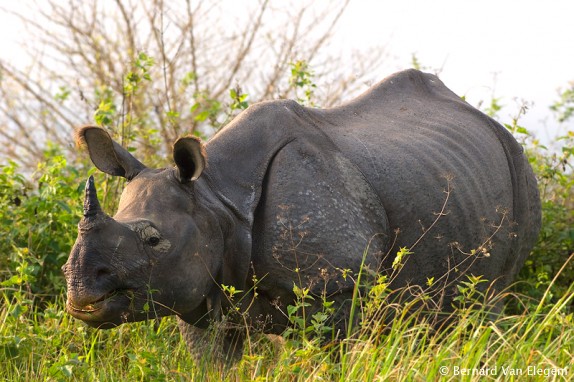Greater One-horned Rhinoceros, Asian One-horned Rhinoceros, Indian Rhinoceros, female - Indische Neushoorn, wijfje - Rhinoceros unicornis
Greater One-horned Rhinoceros is one of the threatened species, which almost depend entirely for their survival on the National Park of Kaziranga. The Greater One-horned Rhinoceros is primarily a grazer, with the grass Saccharum spontaneum comprising a major part of it's diet all year round. During the winter, the Rhino's often also browse the scrub vegegation, which is found more frequently at the edge of the flat and vast alluvial lowland grasslands. They rarely venture more then 2 kilometer away from water. They spend most of their time in the flat alluvial marshes, and rarely roam upwards into the adjacent Shorea robusta hill forests. The only exception to this, is during the monsoon season, when the alluvial floodplains can become completely inundated. The species is classified as Vulnerable on the IUCN Red List. World population is now estimated at about 2700 individuals. The Greater One-horned Rhinoceros was once to be found right across the northern part of the Indian subcontinent, it's range taking in the Indus, Ganges and Brahmaputra river basins, and extending from Pakistan to the Indo-Burmese border. The species was once common in North-West India and Pakistan, where the species already started a quick decline around 1600. The species suffered between 1600 and 1900 a sharp decline all over it's range, and the species faced extinction at the start of the 20th century. Main reasons were habitat loss combined with severe hunting and poaching of the species. During the past centuries huge areas of the natural grasslands in the fertile alluvial floodplains were conversed into agricultural land and this still goes on outside the national parks. Fortunately the numbers have climbed steadily over the past two decades, due to protection programmes and specific park management measures for this species. Despite these measurements, only two populations currently contain more then 100 individuals, Kaziranga, with about 2000 rhinos and Chitwan, with about 450 indivduals. Outside these parks in recent times catastrophic large scale poaching actions took place in several places, where in a very short period some populations were brought on the brink of extinction, such as in Bardia in Nepal.

